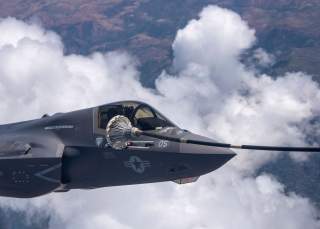Britain's F-35B Is Getting New Toys: The AIM-132 ASRAAM Missile and Paveway IV Bomb
Lots of fun.
The weapon is a guidance kit based on the existing Enhanced Paveway II Enhanced Computer Control Group (ECCG) added to a modified Mk 82 general-purpose bomb with increased penetration performance.
The 461st Flight Test Squadron (FLTS) recently conducted weapon delivery accuracy tests with two U.K. weapons.
The weapons were released from a U.S. Marine Corps (USMC) F-35B Lightning II, short takeoff/vertical landing variant, which will also be used by the U.K’s Royal Air Force (RAF) and Navy, explained Kenji Thuloweit, 412th Test Wing Public Affairs in the article 461st FLTS tests U.K. weapons for F-35B.
The U.K. weapons used for the test were the AIM-132 ASRAAM short-range, infrared-guided missile and Paveway IV precision-guided bomb.
The AIM-132 Advanced Short Range Air-to-Air Missile (ASRAAM) is an infrared homing (“heat seeking”) air-to-air missile, produced by MBDA. It is currently in service in the Royal Air Force (RAF) and Royal Australian Air Force (RAAF), replacing the AIM-9 Sidewinder. The ASRAAM is designed to outrange and outrun any other IR missile in service, allowing the pilot to fire and then turn away long before the opposing aircraft can close for a shot. It flies at well over Mach 3 to ranges as great as 50 kilometres (31 mi). It retains a 50g manoeuvrability provided by body lift technology coupled with tail control. Currently the ASRAAM is carried by the RAF’s Eurofighter Typhoons and Panavia Tornado GR4s.
The Paveway IV is an advanced and highly accurate, state-of-the-art precision guided bomb. It’s an all-weather bomb with inertial navigation and GPS- and laser-guided bombing capabilities that is used by RAF and Royal Navy fighters.
The weapon is a guidance kit based on the existing Enhanced Paveway II Enhanced Computer Control Group (ECCG) added to a modified Mk 82 general-purpose bomb with increased penetration performance. The new ECCG contains a Height of Burst (HOB) sensor enabling air burst fusing options, and a SAASM (Selective Availability Anti Spoofing Module) compliant GPS receiver. It can be launched either IMU (Inertial Measurement Unit) only, given sufficiently good Transfer Alignment, or using GPS guidance. Terminal laser guidance is available in either navigation mode.
According to Collin O’Fallon, F-35 weapon integration engineer, two tests have been conducted with the Paveway IV. The first test was executed at Naval Air Weapons Station China Lake and was a laser-mode employment of the guided bomb against a tank on the ground. The second test took place over Edwards AFB’s Precision Impact Range Area to test the bomb’s GPS/inertial navigation employment against a tank.
“The two Paveway IV live-fires represent full end-to-end weapon-aircraft integration tests for these two significant use cases of this weapon’s employment modes,” said O’Fallon.
Instead, on Feb. 24, one AIM-132 ASRAAM was fired at an unmanned drone over the Point Mugu Sea Range off of the California coast.
“The purpose of the test was to verify that the F-35 system could be used to target and engage an air target with an ASRAAM,” explained Max Heald, 461st FLTS, F-35 weapon integration engineer. “The test also verified that the F-35 properly communicated to the missile and gave it everything it needed to prosecute a target.”
Heald added the data collected in the test provided evidence to the weapon supplier they could use to certify AIM-132 ASRAAM carriage on the F-35B.
The 461st FLTS (besides being responsible for the execution of all mission systems developmental testing for U.K. F-35Bs) and Joint Strike Fighter Integrated Test Force conducts developmental testing and evaluation for all three variants of the F-35 Lightning II.
This article by Dario Leone originally appeared on The Aviation Geek Club in 2017.
Image: DVIDShub.

